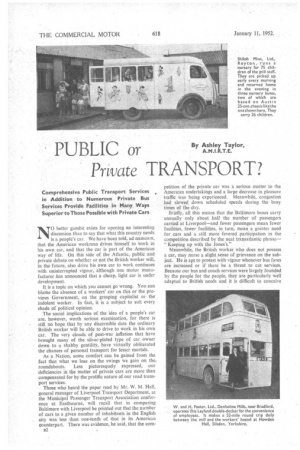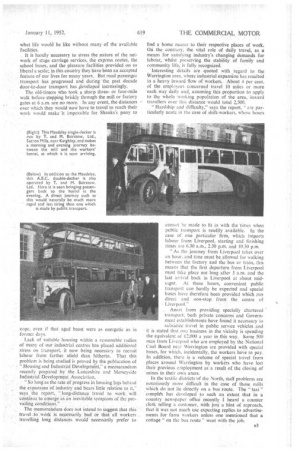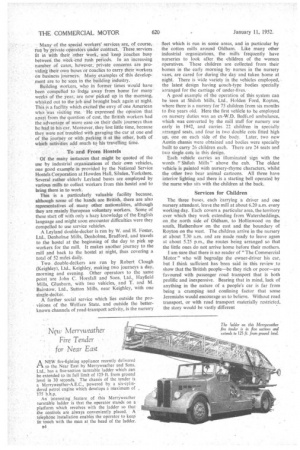PUBLIC or Private TRANSPORT?
Page 36

Page 37

Page 38

If you've noticed an error in this article please click here to report it so we can fix it.
Comprehensive Public Transport Services in Addition to Numerous Private Bus Services Provide Facilities in Many Ways Superior to Those Possible with Private Cars
NO better gambit exists for opening an interesting discussion than to say that what this country needs is a people's car. We have been told, ad nauseam, that the American workman drives himself, to work in his own car, and that the car is part of the American way of life. On this side of the Atlantic, public and private debate on whether or not the British worker will, in the future, also drive his own car to work continues with uninterrupted vigour, although one motor manufacturer has announced that a cheap, light car is under development. •
It is a topic on which you cannot go wrong. You can blame the absence of a workers' car on this or the previous Government, on the grasping capitalist or the indolent worker. In fact, it is a subject to suit every shade of political opinion.
The social implications of the idea of a people's car are, hoWever, worth serious examination, for there is still no hope that by any discernible date the ordinary British worker. will be able to drive to work in his own car. The very clouds of post-war inflation that have brought many of the silver-plated type of car owner down to a shabby gentility, have virtually obliterated the chances of personal transport for lesser mortals.
As a Nation, some comfort can be gained from the fact that what we lose on the swings we gain on the, roundabouts. Less picturesquely expressed, our deficiencies in the matter of private cars are more than compensated for by the prolific nature of our road transport services.
Those who heard the paper read by Mr. W. M. Hall, general manager of Liverpool Transport Department, at the Municipal Passenger Transport Association conference at Eastbourne, will recall that in comparing Baltimore with Liverpool he pointed out that the number of cars to a given number of inhabitants in the English city was • less than one-tenth of that in its American counterpart. There was evidence, he said, that the corn
E2 . petition of the private car was 'a serious matter to the American undertakings and a large decrease in pleasure traffic was being experienced. Meanwhile, congestion had slowed down scheduled speeds during the busy times of the -day.
Briefly, all this means that the Baltimore buses carry annually only about half the number of passengers carried at Liverpool—and fewer passengers mean fewer faeilities, fewer facilities, in turn, mean. a greater need for cars and a still more fevered participation in the competition described by the neat transatlantic phrase" Keeping up with the Jones's."
Meanwhile, the British worker who does not possess a car, may nurse a slight sense of grievance on the subject. He is apt to protest with vigour whenever bus fares are increased or if there be a threat to cut services. Because our bus and coach services were largely founded by the people for the people, they are particularly well adapted to British needs and it is difficult to conceive
what life would be like without many of the available facilities.
It is hardly necessary to stress the nature of the network of stage carriage services, the express routes, the school buses, and the pleasure facilities provided on so liberal a scale; in this country they have been an accepted feature of our lives for many years. But road passenger transport has progressed and during the past decade door-to-door transport has 41eveloped increasingly. The old-timers who took a sharp threeor four-mile walk before stepping briskly through the mill or factory gates at 6 a.m. are no more. In any event, the distances over which they would now have to travel to reach their work would make 'it impossible for Shanks's pony to cope, even if that aged beast were as energetic as in former days.
Lack of suitable housing within a reasonable radius of many of our industrial centres has placed additional stress on transport, it now being necessary to recruit labour from farther afield than hitherto. That this problem is being studied is proved by the publication of • . " Housing and Industrial Development," a memorandum recently prepared by the Lancashire and Merseyside Industrial Development Association.
" So long as the rate of progress in housing lags behind the expansion of industry and .bears little relation to it ' says the report, " long distance travel to work will continue to emerge Is an inevitable symptom of the vailing conditions
The memorandum does not intend to suggest that this _ . travel to .work is necessarily bad or that all workers travelling long distances. woUld necessarily prefer to find a home nearer to their respective places of work. On the contrary, the vital role of daily travel, as a means for satisfying industry's changing demands for labour, whilst preserving the stability of family and community life, is fully recognized.
Interesting details are quoted with regard to the Warrington area, where industrial expansion has resulted in a heavy inward flow of workers. About 4 per cent. of the employees concerned travel 10 miles or more 'each way daily and, assuming' this proportion to apply to the whole working population of the area, inward travellers over this distance would total 2,500.
`! Hardship and difficulty," says the report, "are particularly acute in the case of shift-workers, whose hours
cannot be made to tit in with the 'times when public transport, is -readily .available. In the case of one particular firm, which imports labour from Liverpool, starting and finishing times are 6.30 am., 2.30 p.m. and 10.30 p.m.
"As the journey from Liverpool takes over an hour, and time must be allowed for walking between the factory and the bus or train,. this means that the first departure from Liverpool must take place not long after 5 ant and the last arrival back in Liverpool at about mid1.14nt. At these hours, convenient public transport can hardly be expected and special buses have therefore been provided which run direct and non-stop from the centre of Live rpool ."
Apart fromproviding specially chartered transport, both private concerns' and Government establishments -have found it necessary lO subsidize travel in public service vehicles and . it is stated that one business in the vicinity is spending the equivalent of £2,000 a year in this way. Some 500 men from Liverpool who are employed by the National Coal Board near Warrington are provided with special buses, for which, incidentally, the workers have to pay. In addition, there is a volume of special travel from places around Warrington by workers who have lost their previous employment as a result of the closing of
'mines in their own areas.
In the textile districts'of the North, stall problems are
notoriously more difficult in the case of those mills which do not lie directly on a bus route. The taxi" cornpldx has developed to such an extent that in a country newspaper office recently, .1 heard a counter clerk telling a customer, with just a hint of reproach, that it was not much use expecting replies.to advertisements for farm workers unless one mentioned that a cottage "on the bus route' went -with the job. Many of the special workers services are, of course, run by private .operatOrs under contract. These services fit in with their other Work, and keep coaches busy between the week-end rush periods. In an increasing number of cases, however, private concerns are providing their own buses or coaches to carry their workers on business journeys. Many examples of this development are to be -seen in the building industry.
Building workers, who in former times would have been compelled to lOdge away from home for many weeks of the year, are now picked up in the morning, whisked out to the job and brought back again at night. This is a facility which excited the envy of one American who Was visiting me. He expressed the opinion that apart from the question of cost, the British workers had the advantage of more ease on their daily journeys than tie had in his car. Moreover, they lost little time, because they were not troubled with garaging the car at one end of the journey or with parking it at the other, both of which activities add much to his travelling time.
To and From Hostels Of the many instances that might be quoted of the use by industrial organizations of their own vehicles, one good example is provided by the National Service Hostels Corporation at Howden Hall. Silsden, Yorkshire. Several rather elderly Leyland buses are employed by various mills to collect workers from this hostel and to bring them in to work.
This is a particularly valuable facility because, although some of the hands are British, there are also representatives of many other nationalities, although they are mainly European voluntary workers. SOrtle of these start off with only a hazy knowledge of the English language and might soon encounter difficulties were they compelled to use service vehicles.
A Leyland double-decker is run by W. and H. Foster, Ltd., Denholme Mills, Denholme, Bradford, and travels to the hostel at the beginning of the day to pick up workers for the mill. It makes another journey to the mill and back to the hostel at night, thus covering a total of 52 miles daily.
Two double-deckers are run by Robert Clough (Keighley), Ltd., Keighley, making two journeys a day, morning and evening, Other operators to the same point are John C. Horsfall and Sons, Ltd., Hayfield Mills, Glusburn, with two vehicles,. and T. and M. Bairstow, Ltd., Sutton Mills, near Keighley, with one single-decker. ftirther social service which lies outside the provisions of the Welfare State. and outside the betterknown channels of road-transport activity, is the nursery fleet which is run in some areas, and in particular by the cotton mills around Oldham. Like many other Industrial organizations, the mills frequently have nurseries to look after the children of the women operatives. These children are collected from their homes in the early morning by nurses in the nursery vans, are cared for during' the day and taken home at night. There is wide variety in the vehicles employed, the latest design having i:oach-type bodies specially arranged for the carriage of under-fives.
A good example of the operation of this system can be Seen at Shiloh Mills, Ltd., Holden Ford, Royton, where there is a nursery for 75 children from six months to five years old. Here the first vehicle to be employed on nursery duties was an ex-W.D. Bedfcrd ambulance, which was converted by the mill staff for nursery use early in 1942, and carries 22 children in specially arranged seats, and four in two double cots fitted high up, one on each side of the body. Later, two new Austin chassis were obtained and bodies were specially built to carry 26 children each. There are 24 seats and two single cots in this design.
Each vehicle carries an illuminated sign with the words Shiloh Mills" above the cab. The oldest vehicle is painted with nursery-rhyme characters, whilst the other two bear animal cartoons. All three have interior lighting and there is a starting bell operated by the nurse who sits with the children at the back.
Services for Children
The three buses, each Carrying a driver and one nursery attendant, leave the mill at about 6.20 a.m. every working day. Each covers a particular area, the territory over which they work extending from Watersheddings, on the north side of Oldham, to Hollinwood on the south, Hathershaw on the east and the boundary of Royton on the west. The children arrive in the nursery at about 7.30 a.m. and are made ready to leave again at about 5.25 p.m., the routes being arranged so that the little ones do not arrive home before their mothers.
I am sure that there is no reader of "The Commercial Motor" who will begrudge the owner-driver his car, but I think sufficient has been said in this review to show that the 'British people—be they rich or poor—are favoured with passenger road transport that is both prolific and inexpensive. Bearing that in mind, lack of anything in the nature of a people's car is far from being a cramping and confining factor that some Jeremiahs would encourage us to believe. Without road transport, or with road transport materially restricted, the story would •be vastly different




















































































